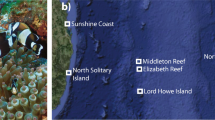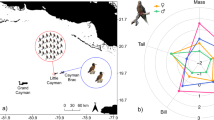Abstract
Shallow subtidal populations of sea anemones occupying hard substrates along the California (Pacific) and Gulf of Maine (Atlantic) coasts of the USA are compared. The diversity of anemones in the southern Gulf of Maine to 35 m is low (4 species) in contrast to similar habitats in California (at least 11 species), but parallel patterns of individual size, distribution and predation impacts occur. Water motion influences depth distribution and size, while predation affects size, population structure and habitat selection. The nudibranch Aeolidia papillosa exerts a similar pressure on population structure in some anemone species in both areas as a size selective predator. The seastar Dermasterias imbricata appears to magnify the selective pressure for large size in the eastern Pacific coastal zone. Interspecific aggression of anemones determines some distribution patterns in areas of overlap.
Similar content being viewed by others
References
Annett, C. & R. Pierotti, 1984. Foraging behavior and prey selection of the leather seastar Dermasterias imbricata. Mar. Ecol. Prog. Ser. 14: 197–206.
Ates, R. M. L., 1989. Fishes that eat sea anemones, a review. J. nat. Hist. 23: 71–79.
Bucklin, A., 1987. Growth and asexual reproduction of the sea anemone Metridium: comparative laboratory studies of three species. J. exp. mar. Biol. Ecol. 110: 41–52.
Bucklin, A. & D. Hedgecock, 1982. Biochemical genetic evidence for a third species of Metridium (Coelenterata: Actiniaria). Mar. Biol. 66: 1–7.
Chadwick, N., 1987. Interspecific aggressive behavior of the corallimorpharian Corynactis californica (Cnidaria: Anthozoa): effects of sympatric corals and sea anemones. Biol. Bull. 173: 110–125.
Denny, M. W., T. L. Daniel & M. A. R. Koehl, 1985. Mechanical limits to size in wave-swept organisms. Ecol. Monogr. 55: 69–102.
Dunn, D. F., 1977. Dynamics of external brooding in the sea anemone Epiactis prolifera. Mar. Biol. 39: 41–49.
Francis, L., 1976. Social organization within clones of the sea anemone Anthopleura elegantissima. Biol. Bull. 150: 361–376.
Francis, L., 1988. Cloning and aggression among sea anemones (Coelenterates: Actiniaria) of the rocky shore. Biiol. Bull. 174: 241–253.
Harris, L. G., 1986. Size-selective predation in a sea anemone, nudibranch, and fish food chain. Veliger 29: 38–47.
Harris, L. G. & K. P. Irons, 1982. Substrate angle and predation as determinants in fouling community succession. In J. Cairns, Jr. (ed.), Artificial Substrates. Ann Arbor Science, Michigan: 131–174
Hoffmann, R. J., 1976. Genetics and asexual reproduction of the sea anemone Metridium senile. Biol. Bull. 151: 478–488.
Jackson, J. B. C., 1977. Competition on hard marine substrate; the adaptive significance of solitary and colonial strategies. Am. Nat. 111: 743–767.
Koehl, M. A. R., 1977. Effects of sea anemones on the flow forces they encounter. J. exp. Biol. 69: 87–105.
Mauzey, K. P., C. Birkeland & P. K. Dayton, 1968. Feeding behaviour of asteroids and escape responses of their prey in the Puget Sound region. Ecology, Brooklyn 49: 603–619.
Purcell, J. E., 1977. Aggressive function and induced development of catch tentacles in the sea anemone Metridium senile (Coelenterata, Actiniaria). Biol. Bull. 153: 355–368.
Sebens, K. P., 1977. Habitat suitability, reproductive ecology, and the plasticity of body size in two sea anemone populations (Anthopleura elegantissima and Anthopleura xanthogrammica). Ph.D. thesis, University of Washington.
Sebens, K. P., 1981. The allometry of feeding, energetics, and body size in three sea anemone species. Biol. Bull. 161: 152–171.
Sebens, K. P., 1986. Spatial relationships among encrusting marine organisms in the New England subtidal zone. Ecol. Monogr. 56: 73–96.
Sebens, K. P. & G. Laakso, 1977. The genus Tealia (Anthozoa: Actiniaria) in the waters of the San Juan Archipelago and the Olympic Peninsula. Wasmann J. Biol. 35: 152–168.
Shick, J. M., R. J. Hoffmann & A. N. Lamb, 1979. Asexual reproduction, population structure, and genotype-environment interactions in sea anemones. Am. Zool. 19: 699–713.
Author information
Authors and Affiliations
Rights and permissions
About this article
Cite this article
Harris, L.G. Comparative ecology of subtidal actiniarians from the coasts of California and the Gulf of Maine, USA. Hydrobiologia 216, 271–278 (1991). https://doi.org/10.1007/BF00026474
Issue Date:
DOI: https://doi.org/10.1007/BF00026474




